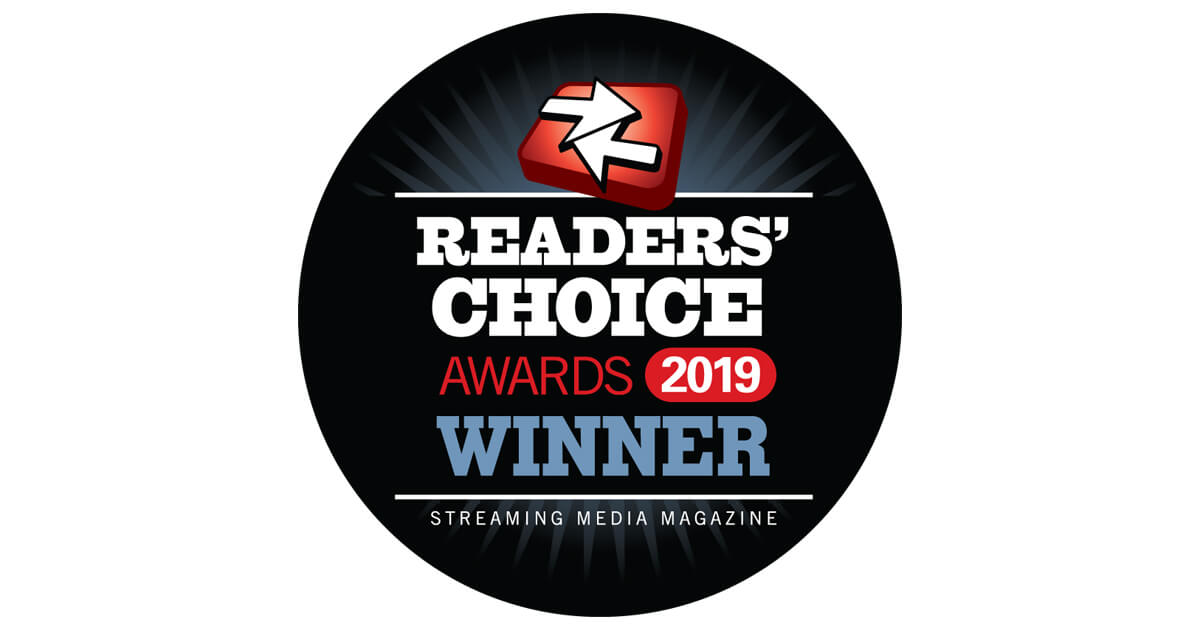Video Streaming Platform News: What You Missed in 2019
2019 has been a major year for the live streaming industry. We’ve seen acquisitions, market shifts, and technological innovations. Every video streaming platform is becoming more capable than ever. At the same time, some of the big players have taken steps to differentiate themselves from the competition
This updated article will review some of the news highlights from the 2019 live streaming industry. Our goal is to update you on trends and changes to help you prepare for business streaming solutions in 2020 and beyond.
What we can count on without question: streaming video viewership will increase! This trend stems, unsurprisingly, from the millennial generation. As usual, they are leading the way worldwide. Today, the youngest internet users watch much more online video than other demographics. However, older viewers are beginning to rely more on online video as well.
With that context in mind, let’s take a look at 9 key video streaming platform highlights from 2019.
Video Streaming Platform News
Online video is a thriving industry, with a video streaming platform suitable for every unique individual and business. To keep up with these trends, it’s important to stay up-to-date on the news of the industry. First up, let’s take a look at some streaming service acquisitions, starting with the Dacast online video platform.
1. Dacast acquired vzaar

In March of 2019, video streaming platform Dacast acquired vzaar.
This merger brought together two leading online video platforms. Since the acquisition, Dacast has rolled out a new, more powerful streaming platform, with advanced streaming solutions. Before 2019, Dacast had offered class-leading live streaming and VOD functionality to its broadcasters around the world. The vzaar service was known for its top-notch VOD features and unique in-China delivery agreement.
This year, Dacast has been adding new features at a rapid pace. Today, Dacast offers low-latency HLS live streaming and an advanced, multi-currency paywall. In addition, Dacast now offers in-China video hosting, an enterprise-grade streaming feature not included with most OVPs today.
2. Brightcove acquired Ooyala
In more streaming platform acquisition news, the OVP Brightcove acquired Ooyala’s OVP business for $15 million in cash and stocks. This merger further strengthened Brightcove’s position as an enterprise online video host.
At first, it seemed that Ooyala would continue to exist as a video workflow services provider, with their video hosting and distribution will be folded into Brightcove. However, Brightcove later announced an end-of-life (EOL) plan for the Ooyala service. By April 2020, current Ooyala broadcasters will need to find an alternative solution for their streaming needs.
3. Market consolidation continues

These acquisitions are part of a trend of increasing consolidation in the video streaming platform market. As the technology matures, an initially diverse marketplace is becoming smaller.
As Eric Schumacher-Rasmussen notes on Streaming Media, “We’ve come a long way from the days when we were tracking dozens of OVPs in the market.” Now, there are fewer OVPs with a long track record of success on the market.
For broadcasters, this can be positive in terms of fewer options to review and compare, and higher-quality services for existing options.
4. The booming OTT industry
By 2020, there will be almost a million minutes of video per second crossing the internet. Much of this will be OTT video content. In 2019, the industry experienced further solidification of OTT as the dominant mass media format of the 21st century. (We’ve written about this in an earlier blog post, too.)
To date, more than 51 million U.S. households use OTT streaming solutions. More specifically, more than 69% of U.S. households subscribe to at least one OTT service. A full 38% subscribe to two or more. In 2019, more than 3 million people will cancel their cable subscriptions. However, this boom doesn’t only reflect a U.S.-based phenomenon. In fact, global OTT subscriptions hit 473 million in 2018.
Businesses are getting in on the action, with estimates suggesting that more than a third of professional broadcasters monetize their content via subscription models. Relatedly, digital ad spending continues to rise as well. And in many countries, the annual growth rate for the OTT market is more than 30 percent. This astronomical growth rate reflects the reality that online video technology and live streaming are now ready for the big leagues.
The numbers are just staggering. And experts predict that meteoric rise will continue in 2020. Overall, worldwide OTT revenue is expected to reach $83.4 billion by 2022.
5. Technological changes: The end of RTMP

As of May 1, 2019, Facebook no longer supports RTMP-based live steaming. Instead, the platform has moved fully to RMTPS, an encrypted version of the same protocol.
We’ve seen other protocol changes as well. In particular, “HLS Direct” live streaming is increasingly popular due to decreased latency it can deliver. RTMP is reaching the point where it will be phased out soon.
(Dacast users should note that we still support RTMP streaming. We will always ensure smooth streaming and maximum reliability as protocols change into the future. You can use Dacast partner Switchboard Live for multi-destination streaming, including streaming an RTMPS-feed to Facebook.)
6. Next-Generation codecs and formats
Next-generation video codecs are nearly ready for the big leagues.
These include HEVC (also known as H.265) and AV1. These codecs are important because they deliver higher quality with lower file sizes compared to common codecs in use today. This is critical to delivering high-quality video, especially on mobile networks and as video quality increases.
Thus far, HEVC “has been hampered by commercial terms that are widely perceived as unreasonable.” However, there are other alternative codecs in development now.
One is AV1, a free codec that resolves the licensing issues of HEVC. However, AV1 continues to experience major compression efficiency issues. Simply put, encoding content with AV1 is very slow and taxes even the highest-end hardware. But encoding speeds are rising rapidly.
7. On the horizon: The upgrade to 5G

\These next-generation codecs are enabling a revolution in video quality. This includes the move to 4K (also known as UHD, Ultra High Definition) for more online video. Internet speeds are also essential for live streaming. And even though speeds have been increasing, the changes have been slow. However, that may be changing.
The coming 5G cell networks will provide speeds roughly 100 times faster than the best available 4G LTE networks. This will make 4K, VR (virtual reality), HFR, and HDR content much more accessible to the everyday viewer.
HDR refers to High Dynamic Range, and HFR refers to High Frame Rate. Increased dynamic range means video that looks better and displays a wider range of colors. Frame rate increases can lead to better-looking video as well. This is especially true when it comes to sports and other high-action video content.
Finally, VR streaming has been on the rise as well. VR is an up-and-coming technology that’s seeing increasing adoption. Rising processing power in devices and faster internet speeds are enabling increased quality and usage of VR. We expect to see VR streaming become common in a few more years.
Companies like Selvz have been expanding VR options. Selvz offers a VR-OTT media player to help companies expand their video content into VR. They do this via the Dacast video streaming platform. Trials and early adoption have continued. Today, it’s a great time to experiment with this option!
8. Growth
The overall trend in the video streaming market is growing. According to We are Social, 70% of marketers plan to use video marketing in 2019. They are using it to help their users grow.
The video streaming market is predicted to be worth $70.5 billion by 2021. Live streaming is making up the majority of that growth.
Any business should be considering the use of video to enable growth. That’s true if you’re an OTT business or sports league that monetizes video directly. It’s true if you’re using video for internal training and communications. It’s true if you’re using video for marketing. And it’s true if you’re using video for just about anything else.
9. Video APIs

Last up in our review of 2019 video streaming platform industry highlights, let’s review the rise of video APIs. Video APIs enable custom integrations, workflows, and app creation.
The use of all types of APIs is exploding. Today, most businesses are migrating to API-based workflows for online video.
According to Streaming Media, “The video workflow and distribution environment is incredibly complex, and the way to build a best-of-breed system or even just gain finer control over tasks—especially when delivering video at scale—is by API.”
Conclusion
As you can see, 2019 has been a big year for live streaming. Iterative change is pushing live streaming steadily forward. Each year, quality is better than the year before. Adoption is also steadily rising. Live streaming via a video streaming platform, like the Dacast OVP, is now more mainstream than ever before.
 In August 2019, Dacast celebrated being named one of the Top 50 Online Video Companies for the second consecutive year. And in November 2019, Dacast earned the Streaming Media Readers’ Choice Award for Best Small/Medium Business Platform – also for the 2nd year running!
In August 2019, Dacast celebrated being named one of the Top 50 Online Video Companies for the second consecutive year. And in November 2019, Dacast earned the Streaming Media Readers’ Choice Award for Best Small/Medium Business Platform – also for the 2nd year running!
On that note, it’s a great time to be involved with live streaming through a video streaming platform. Business is booming, which is leading to satisfied users and successful broadcasters. The rise of video APIs has opened up new creative business possibilities. We hope this article has helped you understand the trends and changes that have informed the live streaming industry today.
If you haven’t tested the Dacast video streaming platform yet, register now for a 14-day free trial (no credit card required).
Any questions, additions, or thoughts? Let us know in the comments section below. We love to hear from our readers and will do our best to respond to every comment. For regular tips on live streaming, feel free to join our LinkedIn group.
 Stream
Stream Connect
Connect Manage
Manage Measure
Measure Events
Events Business
Business Organizations
Organizations Entertainment and Media
Entertainment and Media API
API Tools
Tools Learning Center
Learning Center Support
Support Support Articles
Support Articles